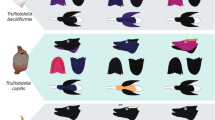Abstract
Silver Lamprey (Ichthyomyzon unicuspis) in the Wisconsin River attached within the branchial cavity of Paddlefish (Polyodon spathula) significantly more often (6.5% of 1,578 attachments) than would be expected by chance on the basis of its relative surface area (3.7%), with as many as four lampreys found together within the branchial cavity of the same Paddlefish. Similar behavior has occasionally been noted for lampreys in other systems, but the phenomenon may be underreported when the lampreys are concealed from view. As suggested previously for some parasitic trychomycterid catfishes, lampreys in the branchial cavity may benefit from accessing blood under pressure, especially in the ventral aorta. In addition, Silver Lamprey within the branchial cavities of Paddlefish may be relatively protected from any negative effects that might result from Paddlefish breaching.

Similar content being viewed by others
References
Bodznick D, Northcutt RG (1981) Electroreception in lampreys: evidence that the earliest vertebrates were electroreceptive. Science 212:465–467
Bur MT (1994) Incidence of the leech Actinobdella pediculata on freshwater drum in Lake Erie. J Great Lakes Res 20:768–770
Burggren WW, Bemis WE (1992) Ram ventilation in the Paddlefish, Polyodon spathula. Physiol Zool 65:515–539
Cochran PA (1986a) The daily timing of lamprey attacks. Environ Biol Fishes 16:325–329
Cochran PA (1986b) Attachment sites of parasitic lampreys: comparisons among species. Environ Biol Fishes 17:71–79
Cochran PA (2004) Historical notes on lampreys in Wisconsin. Am Curr 30(4):4–8
Cochran PA (2009) A comparison of native and exotic hosts for the Silver Lamprey (Ichthyomyzon unicuspis). In: Brown LR, Chase SD, Mesa MG, Beamish RJ, Moyle PB (eds) Biology, management and conservation of lampreys in North America. Am Fish Soc, Symposium 72, Bethesda, Maryland, pp 165–172
Cochran PA, Lyons J (2004) Field and laboratory observations on the ecology and behavior of the Silver Lamprey (Ichthyomyzon unicuspis) in Wisconsin. J Freshw Ecol 19:245–253
Cochran PA, Lyons J, Gehl MR (2003) Parasitic attachments by overwintering Silver Lamprey, Ichthyomyzon unicuspis, and chestnut lampreys, Ichthyomyzon castaneus. Environ Biol Fishes 68:65–71
Hoffman GL (1999) Parasites of North American freshwater fishes, 2nd edn. Cornell University Press, Ithaca
Holzinger JM (1913) Natural history. In: Curtiss-Wedge F (ed) The history of Winona County Minnesota, volume I. H.C. Cooper and Co, Chicago, pp 364–381
Hubbs CL, Potter IC (1971) Distribution, phylogeny and taxonomy. In: Hardisty MW, Potter IC (eds) The biology of lampreys, vol 1. Academic, London, pp 1–65
Kawasaki R, Rovainen CM (1988) Feeding behavior by parasitic phase lampreys, Ichthyomyzon unicuspis. Brain Behav Evol 32:317–329
Kelley WE, Atz JW (1964) A pygidiid catfish that can suck blood from goldfish. Copeia 1964:702–704
Kleerekoper H (1972) The sense organs. In: Hardisty MW, Potter IC (eds) The biology of lampreys, vol 2. Academic, London, pp 373–404
Lennon RE (1954) Feeding mechanism of the Sea Lamprey and its effect on host fishes. US Fish Wildl Serv Fish Bull 56:247–293
Lyons J (1993) Status and biology of the Paddlefish (Polyodon spathula) in the lower Wisconsin River. Trans Wisc Acad Sci Arts Letters 81:123–135
Matthews LH, Parker HW (1950) Notes on the anatomy and biology of the basking shark. Proc Zool Soc Lond 210:535–576
Maxwell G (1952) Harpoon at a venture. Viking Press, New York
Potter IC, Hilliard RW (1987) A proposal for the functional and phylogenetic significance of differences in the dentition of lampreys (Agnatha: Petromyzontiformes). J Zool 212:713–737
Renaud CB (2002) The Muskellunge, Esox masquinongy, as a host for the Silver Lamprey, Ichthyomyzon unicuspis, in the Ottawa River, Ontario/Québec. Can Field-Nat 116:433–440
Renaud CB, Gill HS, Potter IC (2009) Relationships between the diets and characteristics of the dentition, buccal glands and velar tentacles of the adults of the parasitic species of lamprey. J Zool 278:231–242
Roy J-M (1973) Croissance, comportement et alimentation de la lamproie du nord (Ichthyomyzon unicuspis Hubbs & Trautman) en captivité. Trav Pêch Québec No 41. Ministère de l’Industrie et du Commerce, Québec
Runstrom AL, Vondracek B, Jennings CA (2001) Population statistics for Paddlefish in the Wisconsin River. Trans Am Fish Soc 130:546–556
Schutt B (2008) Dark banquet: blood and the curious lives of blood-feeding creatures. Harmony Books, New York
Spotte S (2002) Candiru:life and legend of the bloodsucking catfishes. Creative Arts Book Company, San Francisco
Wagner G (1904) Notes on Polyodon, I. Science 19:554–555
Wagner G (1908) Notes on the fish fauna of Lake Pepin. Trans Wisc Acad Sci Arts Letters 16(1):23–37
Weisel GF (1975) The integument of the Paddlefish, Polyodon spathula. J Morph 145:143–150
Wilkens LA, Hofmann MH (2005) Behavior of animals with passive, low-frequency electrosensory systems. In: Bullock TH, Hopkins CD, Popper AN, Fay RR (eds) Electroreception, Springer Handbook of Auditory Research, vol 21. Springer, New York, pp 229–263
Wilkie MP, Turnbull S, Bird J, Wang Y, Claude JF, Youson JH (2004) Lamprey parasitism of sharks and teleosts: high capacity urea excretion in an extant vertebrate relic. Comp Biochem Physiol, Part A 138:485–492
Zuanon J, Sazima I (2004) Vampire catfishes seek the aorta not the jugular: candirus of the genus Vandellia (Trichomycteridae) feed on the major gill arteries of host fishes. Aqua 8:31–36
Acknowledgements
We thank the many people who helped with field sampling, especially Paul Kanehl.
Author information
Authors and Affiliations
Corresponding author
Rights and permissions
About this article
Cite this article
Cochran, P.A., Lyons, J. Attachments by parasitic lampreys within the branchial cavities of their hosts. Environ Biol Fish 88, 343–348 (2010). https://doi.org/10.1007/s10641-010-9646-5
Received:
Accepted:
Published:
Issue Date:
DOI: https://doi.org/10.1007/s10641-010-9646-5




